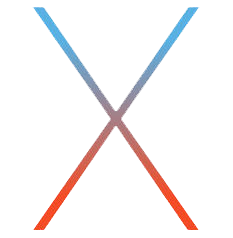macOS

macOS X
macOS X is the name of Apple's desktop operating system. Its features include:
Aqua GUI — Apple's graphical user interface is a highly-iterated facet of the operating system, designed to be a tactile, intuitive and highly-responsive user experience.
Automator — A system utility for automating tasks in the organizational context of a workflow. Added in version 10.4.
Dashboard — A workspace of configurable widgets including sticky notes, news tickers, weather apps, and a standard and scientific calculator. Widgets are arranged on a customizable workspace overlay which can be toggled with a keystroke. Added in version 10.4.
Mission Control — In OS X, every window is a GL object subjugate to larger operating system GUI. Each window can be viewed in real-time as an icon, and the Mission Control interface allows users to quickly navigate and control running applications across multiple virtual desktops. First introduced in summer of 2003, formerly known as Exposé.
FileVault — Provides control of disk encryption, vital in corporate settings. Added in version 10.3.
Screen Sharing — When enabled, allows remote users to view or control the machine. Compatible with standard VNC clients. Added in version 10.5.
Time Machine — Automated file backup service with chronological revision control and a highly-developed visualized metaphor. When using Time Machine to view the history of your backups, the folders and files scroll forward and backward through time like a circular card file or rolodex. Added in version 10.5.
Sad Mac errors
If the "happy Macintosh" and the "Welcome to Macintosh" screens appear before the "sad Macintosh," the problem is probably in the system software.
When the "sad Macintosh" face appears immediately at power up, it usually means a hardware problem. Many common hardware issues are problems with SIMMs or hard drive.
System bomb errors
| 1 | Bus error. |
| 2 | Address error. |
| 3 | Illegal instruction. |
| 4 | Division by zero. |
| 5 | Rage check error. |
| 6 | Overflow. |
| 7 | Privilege violation. |
| 8 | Trace mode error. |
| 9 | Line 1010 trap. |
| 10 | Line 1011 trap. |
| 11 | Hardware exception error. |
| 12 | Unimplemented core routine. |
| 13 | Uninstalled interrupt. |
| 14 | I/O core. |
| 15 | Floating point error. |
| 17 | List manager not present. |
| 18 | Bit edit not present. |
| 19 | Disk initialization package not present. |
| 20 | Standard file not present. |
| 21 | SANE not present. |
| 22 | SANE transcendental functions not present. |
| 23 | International utilities not present. |
| 24 | Binary-decimal conversion package not present. |
| 25 | Out of memory. |
| 26 | Bad program launch. |
| 27 | File system map trashed. |
| 28 | Stack ran into heap. |
| 29 | AppleShare error. |
| 30 | Disk insertion error. |
| 31 | No disk inserted. |
| 32-50 | Memory manager error. |
| 41 | The Finder is not found on the disk. |
| 51 | Unserviceable slot interrupt. |
| 52-53 | Memory manager error. |
| 81 | Bad SANE opcode. |
| 84 | Menu purged while in use. |
| 85 | Couldn't load MBDF. |
| 86 | Couldn't load hierarchical menu's parent. |
| 87 | Couldn't load WDEF. |
| 88 | Couldn't load CDEF. |
| 90 | Floating point coprocessor not installed. |
